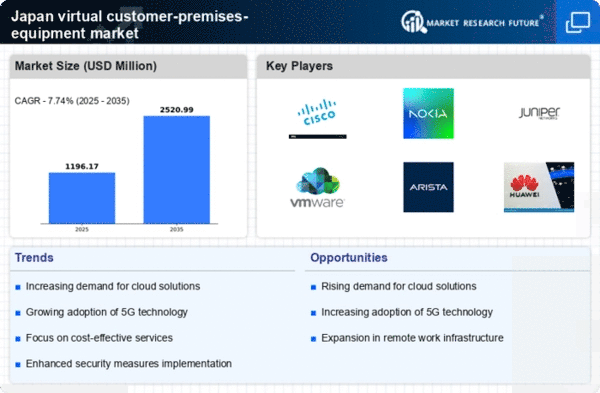Rising Demand for Flexible Network Solutions
The virtual customer-premises-equipment market in Japan is experiencing a notable surge in demand for flexible network solutions. Businesses are increasingly seeking to adapt their network infrastructures to accommodate fluctuating workloads and evolving technological requirements. This shift is driven by the need for agility in operations, allowing companies to scale their services efficiently. According to recent data, the market is projected to grow at a CAGR of approximately 15% over the next five years. This growth is indicative of a broader trend where organizations prioritize flexibility and responsiveness in their network strategies, thereby propelling the virtual customer-premises-equipment market forward.
Growing Importance of Remote Work Capabilities
The rise of remote work capabilities is reshaping the virtual customer-premises-equipment market in Japan. As organizations adapt to new work environments, the demand for robust and secure networking solutions has intensified. Virtual customer-premises equipment provides the necessary infrastructure to support remote operations, ensuring seamless connectivity and collaboration among distributed teams. This trend is expected to continue, with projections indicating that remote work solutions will account for a significant portion of the market by 2026. The ability to maintain productivity and operational efficiency in a remote setting is driving businesses to invest in virtual customer-premises equipment.
Shift Towards Cost-Effective Networking Solutions
The virtual customer-premises-equipment market is witnessing a shift towards cost-effective networking solutions as organizations in Japan strive to optimize their operational expenditures. Companies are increasingly recognizing the financial benefits of deploying virtual solutions over traditional hardware-based systems. This transition is not only reducing capital expenditures but also minimizing ongoing maintenance costs. Market analysis indicates that businesses can save up to 30% on networking costs by implementing virtual customer-premises equipment. This economic advantage is likely to drive further adoption, as firms seek to enhance their competitive edge while managing budgets effectively.
Increased Focus on Network Performance and Reliability
In Japan, there is an increased focus on network performance and reliability, which is significantly impacting the virtual customer-premises-equipment market. Organizations are prioritizing high-performance networking solutions to ensure uninterrupted service delivery and optimal user experiences. This emphasis on reliability is prompting businesses to adopt virtual customer-premises equipment that can provide enhanced performance metrics and uptime guarantees. Market data suggests that companies are willing to invest up to 25% more in solutions that offer superior performance and reliability. This trend indicates a growing recognition of the critical role that network performance plays in overall business success.
Government Initiatives Supporting Digital Transformation
In Japan, government initiatives aimed at promoting digital transformation are significantly influencing the virtual customer-premises-equipment market. The government has launched various programs to enhance digital infrastructure, which includes investments in advanced networking technologies. These initiatives are designed to foster innovation and improve connectivity across sectors. As a result, businesses are encouraged to adopt virtual customer-premises equipment solutions to align with national objectives. The financial backing and policy support from the government are expected to drive market growth, with estimates suggesting an increase in adoption rates by over 20% in the coming years.

















Leave a Comment